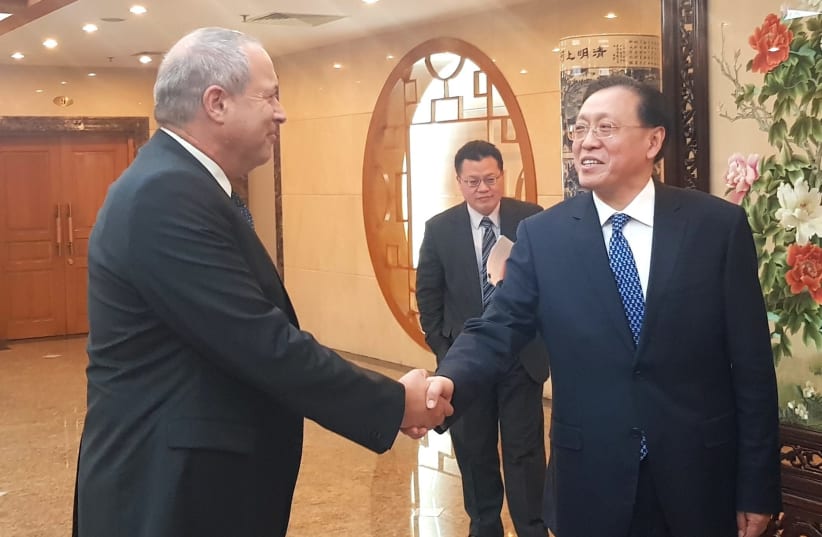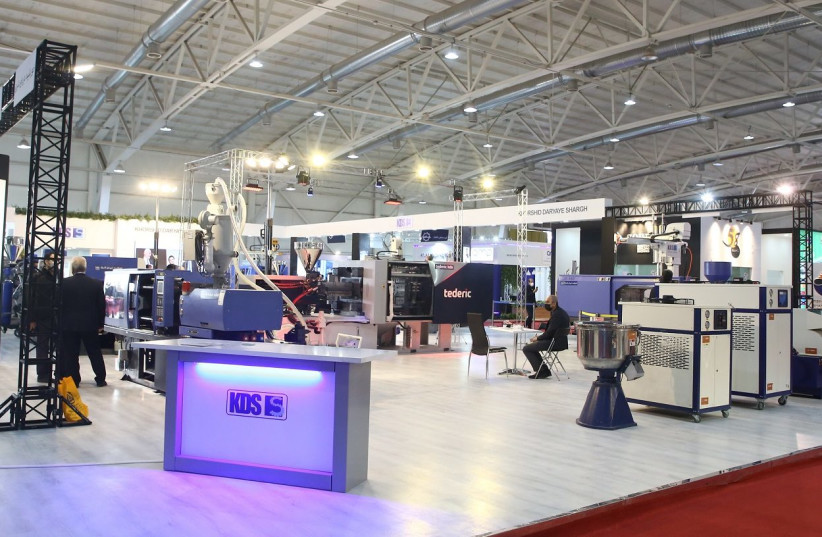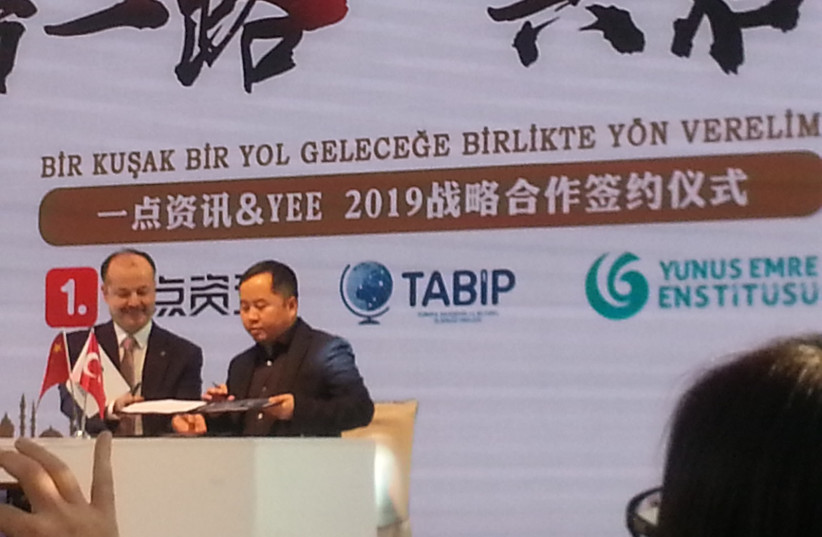China has become a very important source of investment in the Middle East and North Africa in recent years. Its economic influence has expanded as never before, and it is expected to keep growing.
Nicholas Lyall, an Amman-based freelance research consultant on Middle East affairs and conflict systems, is currently completing project work on Syria for the Gaziantep, Turkey-based Operations and Policy Center think tank, and a Peking University Yenching Scholar examining China’s growing engagement in the Levant.
He told The Media Line that accessing energy supplies is the driving force behind China’s relations with the Middle East.
Chen-Che Hsu, a policy analyst at the Access Partnership public policy consultancy, told The Media Line that over the last decade, we have witnessed a notable increase in Chinese investment in the region following the launch of the Belt and Road Initiative (BRI).
“This is reflected in the dramatic increase in China’s outward FDI [foreign direct investment] in the MENA region from $7 billion in 2012 to nearly $24 billion in 2020,” he said.
BRI is a global infrastructure development strategy adopted by the Chinese government in 2013 that aims to connect Asia with Africa and Europe via land and maritime routes.
This long-term Chinese policy seeks to develop infrastructure and stimulate the economic integration of countries along the route of the historic Silk Road.
Joe Hepworth, the Middle East director for the OCO Global economic development consultancy, told The Media Line the region is an obvious node on the BRI, just as it was a key part of the Silk Road.
“As well as being an important trade and investment market in itself, the Middle East is also a staging point for growing Chinese activities in Africa and the Indian Ocean, all of which are very accessible from the region with its excellent transport links [air and maritime],” he added.
China sees the region as a key forum to extend its diplomatic and economic influence, particularly at the US’s expense and Washington’s approach to the Gulf has been somewhat ambiguous over several administrations now, Hepworth said.
The Middle East is a diverse region and although China has increased its involvement in every country in the area the situation is different in each.
Turkey
Turkey, in addition to its large population (about 85 million) and developed technology sector, is in a highly strategic geopolitical location, which attracts significant Chinese interest in the country.
Ulusoy Erdogan, board member of BSN Blockchain-based Service Network (a Chinese government-backed information infrastructure initiative) in Turkey and the general secretary of the Turkish-Chinese Business Development and Friendship Association, told The Media Line that Chinese investment in Turkey has reached new heights.
“The Chinese companies’ investments in the infrastructure, finance, energy, logistics, and telecommunication sectors in our country in the last five years, I guess, have reached the level of $5 billion. That is about two-thirds of all Chinese investment [in Turkey over the past 20 years],” he said.
Cumhur Coşkun Küçüközmen, a professor of international trade and finance at İzmir University of Economics, explained to The Media Line that recently, and particularly with the BRI, China has been quite active in Turkey and the wider region.
Energy and transport infrastructure, as well as telecommunications and banking, are the top sectors for investment, Küçüközmen said.
Erdogan said that although China’s largest investment (approximately $920 million) in Turkey is in the Kumport Container Terminal, on the European side of Istanbul, investment by technology companies such as Huawei and Alibaba in previous years and Oppo and Xiaomi in recent years attract attention.
Küçüközmen added, however, that despite the impressive investment, it pales compared to the trade numbers.
“As of 2021, China is Turkey’s second-biggest trade partner, with a total volume of $36 billion and a $28 billion trade deficit [for Turkey],” he said.
Trade has been the most important element of cooperation between the countries of the region for thousands of years, “and we foresee that this situation is being re-evaluated with new opportunities brought by advanced technology,” said Erdogan.
United Arab Emirates
The United Arab Emirates is one of the most important focal points for Chinese economic activity in the Middle East.
Hepworth said Chinese interests have been building in the region for decades now.
However, he added, “a very obvious and noticeable step-change came in late 2016 when the UAE granted Chinese nationals visa-on-arrival status, which had an immediate positive impact on Chinese tourism and business visitors.”
About 200,000 Chinese nationals live in the UAE, he said.
Today, China has active companies and entities across the spectrum of industries in the UAE. Hepworth explained that China is mostly involved in infrastructure projects, engineering, procurement and construction work, technology, transport, and logistics.
The technological involvement was catalyzed by Expo 2020 in Dubai, he continued. There, “the Terminus Group provided the robots for the mega-event and the company is setting up its MENA HQ at the Expo site – called District 2020 – in the coming months,” he added.
In the transport and logistics sector, he added, “Chinese firms have invested approximately $1.63 billion in a variety of investments at Abu Dhabi’s KIZAD port.”
Hepworth added that various Chinese state-owned enterprises have been heavily involved in the construction, development, and operation of the UAE’s Etihad Rail project for many years now, “which has included everything from constructing the track to supplying the rolling stock.”
Israel
The Chinese have significantly increased their economic involvement in Israel.
Ilan Maor, managing partner at SHENG Enterprises, an Israel-China investment banking and advisory group, and president of the Israel-China Chamber of Commerce, told The Media Line that China has invested around $20 billion in Israel over the past two decades.
This is an impressive number but at the same time modest in comparison to the American and European investment in the country, he said.
About half of Chinese investment in Israel is aimed at the technological sectors (health care, information and communications technology, semiconductors, cleantech), with the rest targeting infrastructure, natural resources, and agriculture, Maor said.
He noted that the two most significant investments in Israel have been outside the technology sector: the acquisition of agro-chem company Adama (Makhteshim Agan) by ChemChina, and the acquisition of the food group Tnuva by the Shanghai-based Bright Food Group.
“China sees strategic value in the Middle East as it is not only an energy supplier but also an export market and target for Chinese infrastructure groups. Israel in this regard is different as the main interest is in its technology,” said Maor.
The main goal of the Chinese investment in Israel “is to benefit from the access to revenues and to [capital] exit generating opportunities, as well as to advanced technologies,” he said.
Maor added that Chinese investments in Israeli technology companies have gone hand in hand with acquisitions of Israeli-developed intellectual property. And, as opposed to some Chinese-invested companies in the US, those in Israel maintain a strong presence, while in some cases also open or strengthen operations in China,” he said.
About a quarter of Chinese investments in Israeli technology is directed at the healthcare sector, with most of that in medtech and a smaller portion in pharmaceutical companies.
China has also invested heavily in Israeli infrastructure projects, including the Tel Aviv light rail system and the country’s main ports. The state-owned China Harbor Engineering Company won a tender in 2014 to construct a private terminal in Ashdod. The Shanghai International Port Group, also state-owned, won a 2015 tender to operate a new port terminal in Haifa Bay for 25 years. Maor mentioned how experienced and active China is in the ports industry all over the world, especially after the BRI was launched. “It is only natural therefore that Chinese groups joined the ports’ tenders in Israel and won,” said Maor.
Because of that, he added, “the US has voiced concern over Chinese involvement in Israel’s infrastructure projects, which intensified the evaluation and planning process within the Israeli government, considering the framework for future involvement of foreign groups in strategic infrastructure projects in Israel.”
Iran
Iran has been heavily dependent on China from an economic point of view since the country became isolated after the Islamic Revolution of 1979.
M.N., an Iranian trade adviser who asked to be identified by her initials only, told The Media Line that because of the sanctions imposed on Iran after the revolution, “Chinese goods and services were the top import market to Iran, replacing the European goods, and that is how China became a significant export market for Iran as well.”
She added that since 2018, when the US withdrew from the nuclear deal and reinstated sanctions, trade between Iran and China significantly increased.
The sanctions reduced Iran’s ability to sell oil and prevented it from repatriating money from energy sales, explained M.N. “So China supported Iran mainly in the oil trade, auto market, and high-tech,” she said.
She also noted the attraction of Iran’s geographical location for China, as historically it was part of the Silk Road connecting East and West Asia.
Lastly, M.N. said that as Beijing has always been a stable economic partner for Iran, Iranian traders are more comfortable looking to China than trying to link up with Americans or Europeans.
Saudi Arabia
Saudi Arabia is important to China as one of the larger economies in the region and the world’s biggest crude oil exporter.
Aziz Omar, who has been working in Chinese-Saudi business and social relations for 15 years, told The Media Line this economic relationship has been growing since the 1990s.
Today, he explained, the Chinese economy plays a great role in Saudi Arabia, especially in the commodities of daily life and in building materials. About 70% of these goods are imported from China.
“Chinese imported goods are involved in most of Saudi life. Your eyes won’t miss a Chinese product if you walk in any supermarket or street,” Omar said.
China is very interested in the Saudi infrastructure sector, but “Chinese as contractors are competing in this field with American, French, Korean and Turkish firms,” he said.
He noted that Chinese companies invest large sums in construction projects and ceramic factories.
One reason the Chinese role in Saudi Arabia is so high is because of the kingdom’s attractive foreign investment policy, which is based on a low tax rate, Omar said.
Jordan
Lyall told The Media Line that the growing Sino-Jordanian economic partnership was especially evident in 2015, which saw Chinese investment agreements worth more than $7 billion signed across Jordan’s transportation, energy, and trade sectors.
Those might be relatively small sums for China, but for Jordan, they are very significant.
“Such developments have led to China consolidating itself as the kingdom’s second-largest commercial partner, with a trade exchange volume of $3.84 billion logged in 2017, the balance of which unsurprisingly being heavily in China’s favor,” said Lyall.
One of the most important Chinese investments in Jordan is in infrastructure.
“The Chinese company Touchstone proposed to deliver a $4.23 billion freight rail project that will connect Jordan’s industrial zones to the Red Sea, Syria, Iraq, and Saudi Arabia,” he said.
As for Chinese investments that are confirmed to be completed, Lyall mentioned the development of Jordan’s first shale oil power plant, in Karak.
“Largely funded by Chinese state-owned banks and planned to be built by a consortium of Chinese companies and Jordan’s Al Lajjun Oil Shale, the plant is set to provide Jordan with 15% of its ongoing energy needs,” he said.
Other energy infrastructure investments are also on Beijing’s radar.
Lyall noted, however, that the Chinese economic engagement in the country is not close to that of the United States.
“Since the start of the BRI, Chinese investments and construction contracts in Jordan have amounted to approximately $700 million per year. In comparison, World Bank funding for Jordan for the five years between 2016 and 2020 averaged $730 million per year, and the IMF will loan around $325 million to Jordan each year between 2020 and 2024,” he said.


